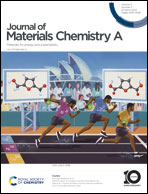Operando X-ray scattering study of segmented thermoelectric Zn4Sb3†
Abstract
The inexpensive and high-performing thermoelectric material β-Zn4Sb3 is a mixed ionic-electronic conductor, which suffers from stability issues due to Zn migration in the structure under thermoelectric operating conditions. Previous ex situ studies have shown that ion migration in β-Zn4Sb3 and Cu2Se can be reduced in segmented modules, where ion-blocking interfaces increase the critical voltage across the module before metallic whiskers are observed at the surface. Here, we use spatially resolved operando X-ray scattering measurements across the pellet coupled with electrical resistivity measurements to examine the stability improvement obtained in segmented β-Zn4Sb3 pellets with ion-blocking steel interfaces under thermoelectric operating conditions. Quantitative phase analysis shows that β-Zn4Sb3 decomposes into ZnSb and Zn, but the rate is significantly reduced in segmented pellets compared with unsegmented pellets. The greatest improvement is found under the mildest conditions investigated, with a hot side temperature of 250 °C and an applied current density of 0.5 A mm−2. Microstructure analysis by scanning electron microscopy and energy dispersive X-ray spectroscopy after stability tests reveals a Zn phase front during migration, as well as residual β-Zn4Sb3 islands trapped inside the decomposed ZnSb phase. Overall, the operando approach provides a dynamic atomic structure basis for the effect of segmentation on the stability of β-Zn4Sb3 under thermoelectric working conditions.



 Please wait while we load your content...
Please wait while we load your content...